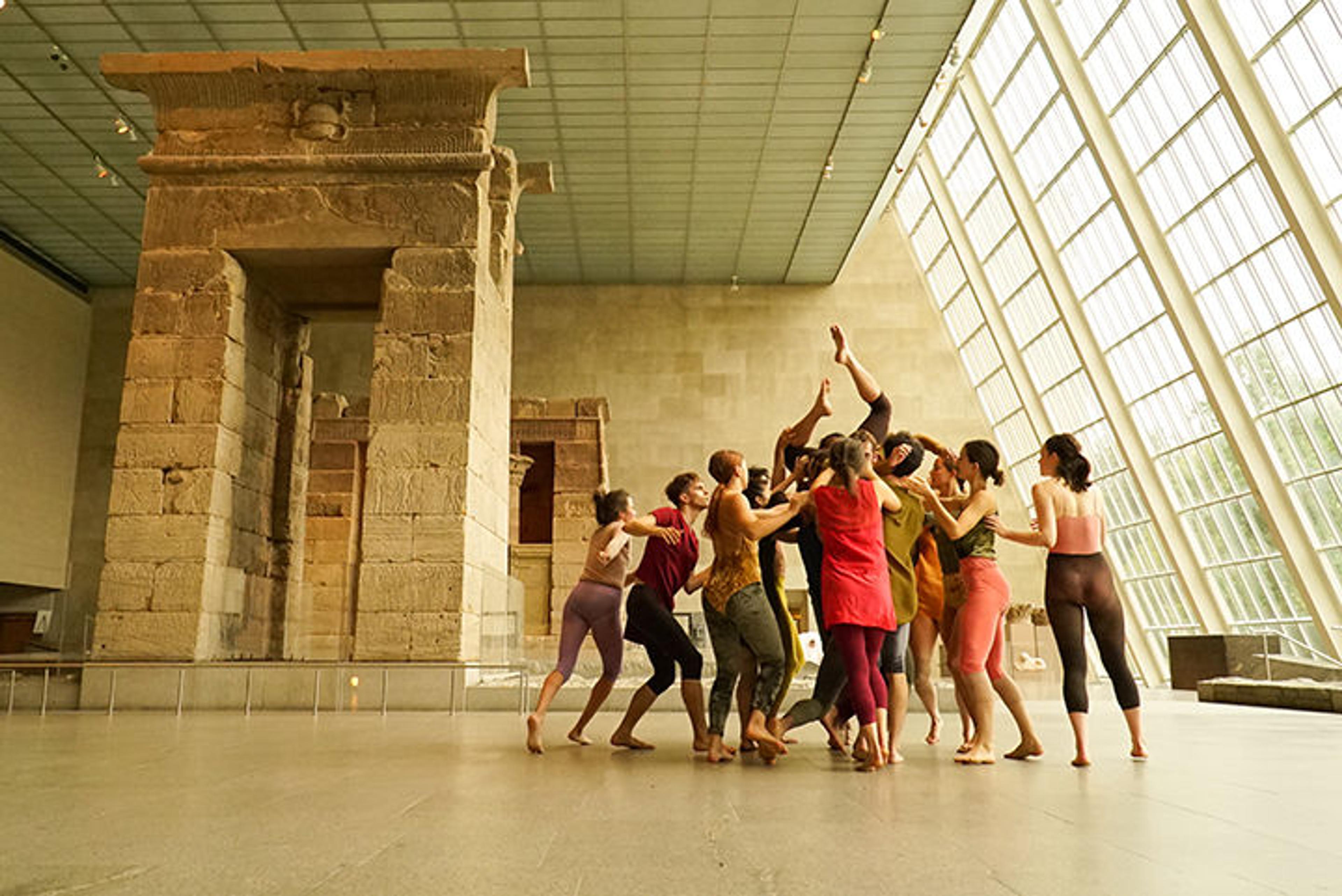
Andrea Miller performs Stone Skipping at the Temple of Dendur in The Sackler Wing. Photos by Ani Collier
«For several weeks, the 2017–18 MetLiveArts Artist in Residence—choreographer and artistic director Andrea Miller of Gallim Dance—has been rehearsing her new work, Stone Skipping, in the Temple of Dendur. The gallery is still open to the public, and visitors freely pass through, but many are noticeably surprised to see dancers moving across the lower platform in front of the temple. As music subtly fills the space, the dancers pair together, intertwining and then peeling apart. So do the visitors, as they connect with the rehearsal and then disperse on their way to another gallery.»
Stone Skipping will premiere at the Temple of Dendur in The Sackler Wing on October 28 and 29, 2017. It is Miller's debut as artist in residence at The Met. Performed by ten Gallim company members and six guest dancers from the Juilliard School, this new work is inspired by the temple, one of the Museum's most iconic artifacts, and considers its history, journey, preservation, and cultural significance. Miller has choreographed a work that is impactful—she is a master at making her lithe dancers move in a way that commands the space—but also intricate and exploratory, with beautiful, highly physical moments of partnering and supported movement.
While there have been other dance performances at the temple—as well as works inspired by and staged in the gallery, such as I Was Here I Was I, a musical-theater work performed in 2014—Stone Skipping is the first evening-length dance performance created specifically for the Temple of Dendur. Just days ahead of the premiere, Miller shared details about the work, as well as what it's like to rehearse in front of a live audience.
Meryl Cates: Stone Skipping began as a work-in-progress, performed last year. Now that you have spent so much time at the Temple of Dendur and in the gallery, how much has the performance evolved since then?
Andrea Miller: The work-in-progress was the beginning of a new movement language I developed upon researching natural life cycles and movement expressions in the non-human natural world. In the studio, we refer to this language as "Nat Geo." This research has really defined how the piece has evolved, which is unusual in my experience of creating work; more often I start somewhere and end up in a completely different place. Maybe this happened because the temple has left a profound impression ever since I first walked into the space. The temple and its survival through time have become a constant premise of the work. The piece has also expanded to include a circle of collaborators, bringing to it an original score, live music, costume design, and partnership with the Juilliard School dancers.

Andrea Miller performs Stone Skipping at the Temple of Dendur
Meryl Cates: Tell us about the major themes of Stone Skipping and how it relates to the temple.
Andrea Miller: The work considers the life cycle, survival, and evolution of the temple from a temple and a monument of religious and political significance 2,000 years ago to an artifact or a historic and cultural object and subject today. The question of where the temple might be, or what it might become 2,000 years from now, is also a commanding theme, as is, by extension, the question of where we are as natural beings, and as humanity, in this life cycle—especially since science is telling us that we're in the middle of the sixth and fastest mass extinction of life and that unprecedented changes to climate and other eco-systems are happening in great part due to environmental degradation resulting from human activity and our unsustainable consumption and predation of nature.
Meryl Cates: What is the open rehearsal process like, with Museum visitors watching as you work on the piece?
Andrea Miller: Sometimes I feel so at home in the space that I don't even notice people. I'm so focused on the dancers and the temple, it's as if we are alone. Other times, I notice that people are behaving differently while we are rehearsing. They stay longer in the space. It looks like they take in the space more, instead of walking through it. It's as if there's a dialogue they are invited to enter into, even one as simple as "What is going on? What does this mean?" I perceive subtle changes in their attitude, from being observers of an inanimate object to being interlocutors in a living space. I love it.
Meryl Cates: For the entire year you are fully integrated into The Met—you are doing workshops, open rehearsals, and ticketed as well as free-with-Museum-admission performances. What are you most excited to share with audiences during your residency?
Andrea Miller: I'm focused on bringing embodiment into a space that is defined by materials, objects, and artifacts. These are all masterpieces of art and of our history; but nevertheless the living body isn't present as a representative of our history, art, or expression of our human existence. I feel like we're representing this deep part of our culture—art—and searching for meaning.
Related Links
2017–18 Artist in Residence: Andrea Miller and Gallim Dance
For a history of dance at The Met leading up to Andrea Miller's residency, read "A Timeline of Dance Highlights at The Met."